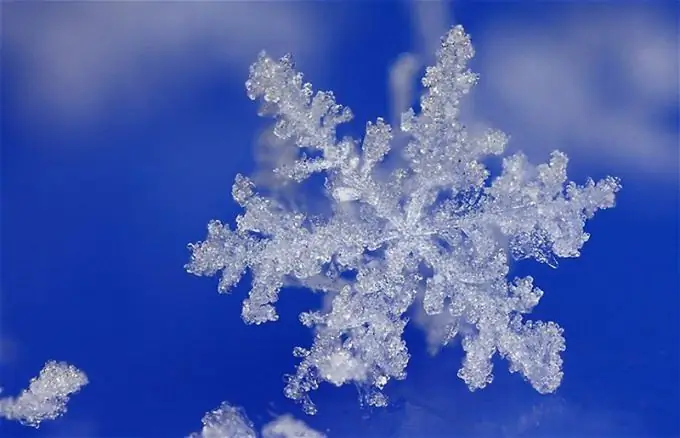Snow formation is a rather complex physical and geographical phenomenon that can be explained in different ways from different points of view. However, the laws of physics help to interpret its nature best.

Instructions
Step 1
Essentially, snow is just frozen water. However, it does not at all look like the transparent pieces of ice that usually cover frozen bodies of water. In fact, snowflakes also consist of ice, only not of a homogeneous mass, but of the smallest crystals. Their many facets reflect light in different ways, so the snowflakes appear white and not transparent as they really are.
Step 2
Snow is formed from steam in the atmosphere and freezes at low temperatures. First, clear transparent crystals appear. Then they are picked up by the air stream, and they are carried away in many different directions. Needle and flat crystals are found, but most of them are hexagonal in shape.
Step 3
In the air, tens and hundreds of crystals stick to each other until their size grows so much that they fall under the influence of gravity and slowly begin to descend to the ground. Despite the fact that all snowflakes are arranged in the same way, no one has yet managed to find 2 snowflakes with an absolutely identical pattern.
Step 4
Scientists have managed to count more than 5,000 possible shapes of snowflakes. There is even an international classification, according to which snowflakes are subdivided into stars, plates, columns, needles, hail, tree-like crystals, etc. Their sizes range from 0.1 to 7 mm. In order to acquire a perfectly symmetrical shape, a snowflake should rotate when it falls like a top.
Step 5
After landing, the snowflakes gradually lose their exquisite beauty and graceful shape, turning into small round lumps. When they fit into a uniform snow cover, air layers form between the snowflakes. For this reason, snow does not conduct heat well and is an excellent "blanket" that covers the ground and protects the plant roots hiding in it from the cold.
Step 6
It is known that the largest snowflakes fell in Moscow on April 30, 1944. Having fallen on the palm, they almost completely covered it and looked like exquisitely beautiful feathers of huge birds. Scientists thus explained what happened: a wave of cold air descended from the side of Franz Josef Land, the temperature dropped sharply, and snowflakes began to form. At the same time, warm air currents rose from the ground, delaying their fall. Remaining in the air layers, the snowflakes stick together and form unusually large flakes. Towards evening, the ground began to cool down, and a fantastic snowfall began.







